Chris Kridler
Chris Kridler is a writer, photographer and storm chaser and author of the Storm Seekers Series of storm-chasing adventures.
Chris Kridler is a writer, photographer and storm chaser and author of the Storm Seekers Series of storm-chasing adventures.
On May 28, Alethea Kontis and I hit the road in Childress, Texas, with Jason Persoff, Dave Lewison and Scott McPartland. Our first target was the Midland area, but it looked as if the target was shifting south into tough chase territory (rugged hills). And even if Midland had remained the most likely target, the frustrating construction nightmare had us changing direction and heading for eastern New Mexico.
This choice illustrates a typical chaser’s dilemma: Go for the more likely tornado, which may not be that easy to catch or see if it happens because of territory or congestion, or chase the more visible, accessible storms. These days, with so many chasers on the road, I really like secondary targets. And even though we didn’t see a tornado, I am thrilled with what we saw in New Mexico.
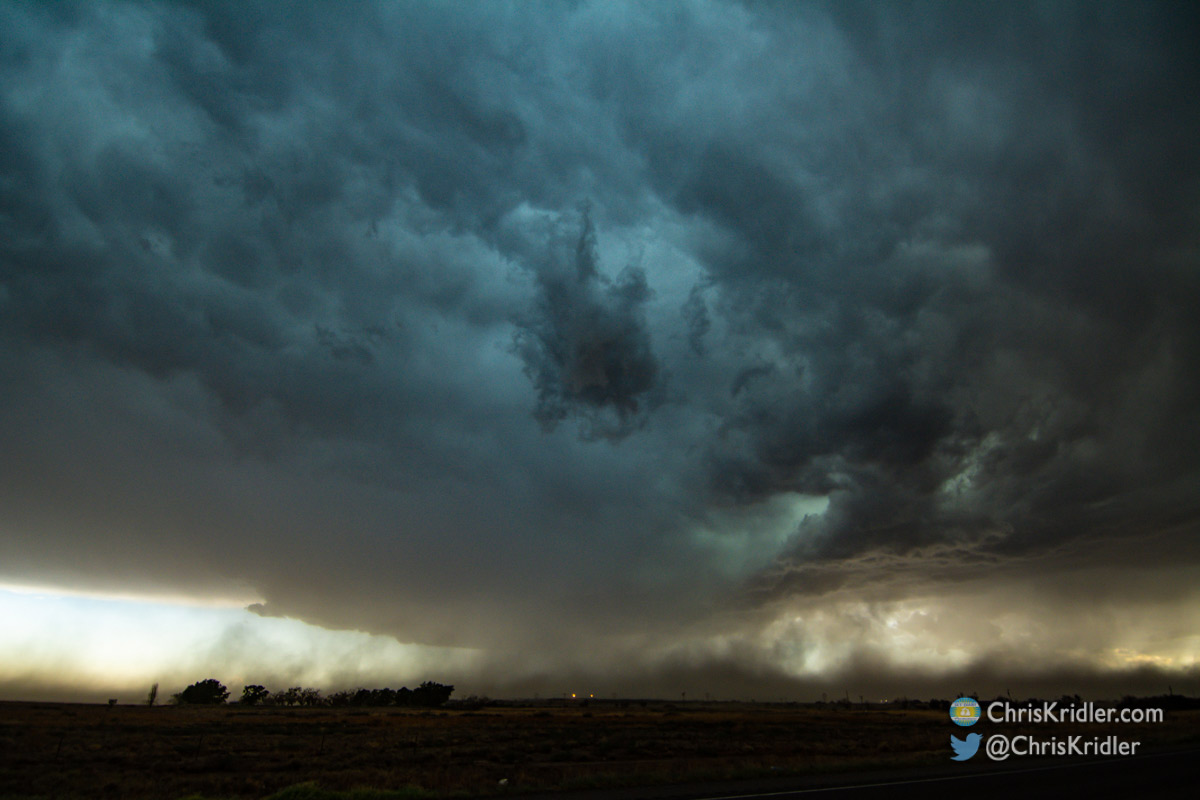
We paused on the side of the road to get a few shots of this supercell after driving amid gustnadoes and the gust-out of another storm.
We were already behind the eight-ball by the time we neared Roswell, with ongoing rotating storms emerging from the higher elevations. Yet we were greeted by an eerie sight – blowing dust, gustnadoes from a dying storm to the north, strange green light and a beast of a supercell in front of us. It was like driving into a sci-fi movie.
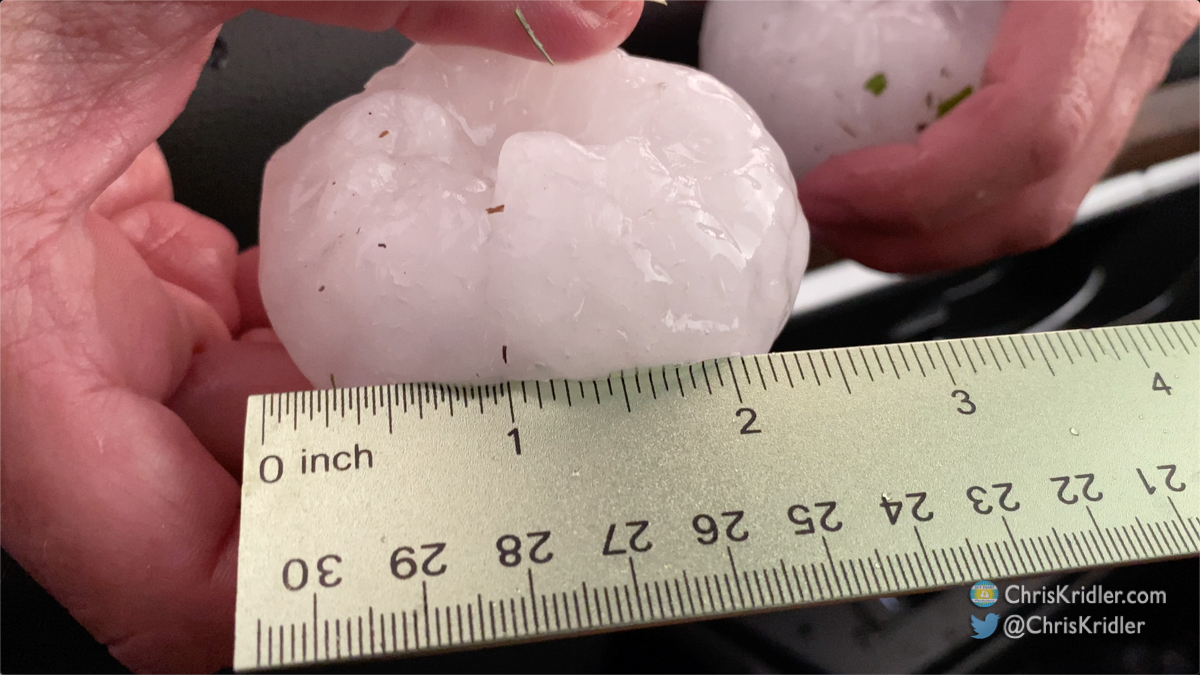
We picked up large hailstones from the side of the road south of Roswell.
The storm was full of hail, and Scott and Dave went ahead in their well-shielded car as we dropped south. Except a big hailstone bounced off their hail shield and took out a side mirror. The rest of us hung back but still got into some fun smaller hail and took photos of baseball-size hailstones we found by the side of the road. The trees in that area were shredded by the bombardment.

Lightning mammatus, hail – and water towers, of course.
Finally, we saw multiple funnel clouds and were treated to an insanely orange sunset and a double rainbow. The chase concluded with beautiful lightning amid the mammatus at Artesia. And Alethea and I made one more stop on our way back to Roswell for the night, capturing spectacular stars above the retreating lightning storms.
Not bad for a roundabout 559-mile chase.
Roll over a photo below to see the caption, or click on any image to start a slide show of larger pictures.
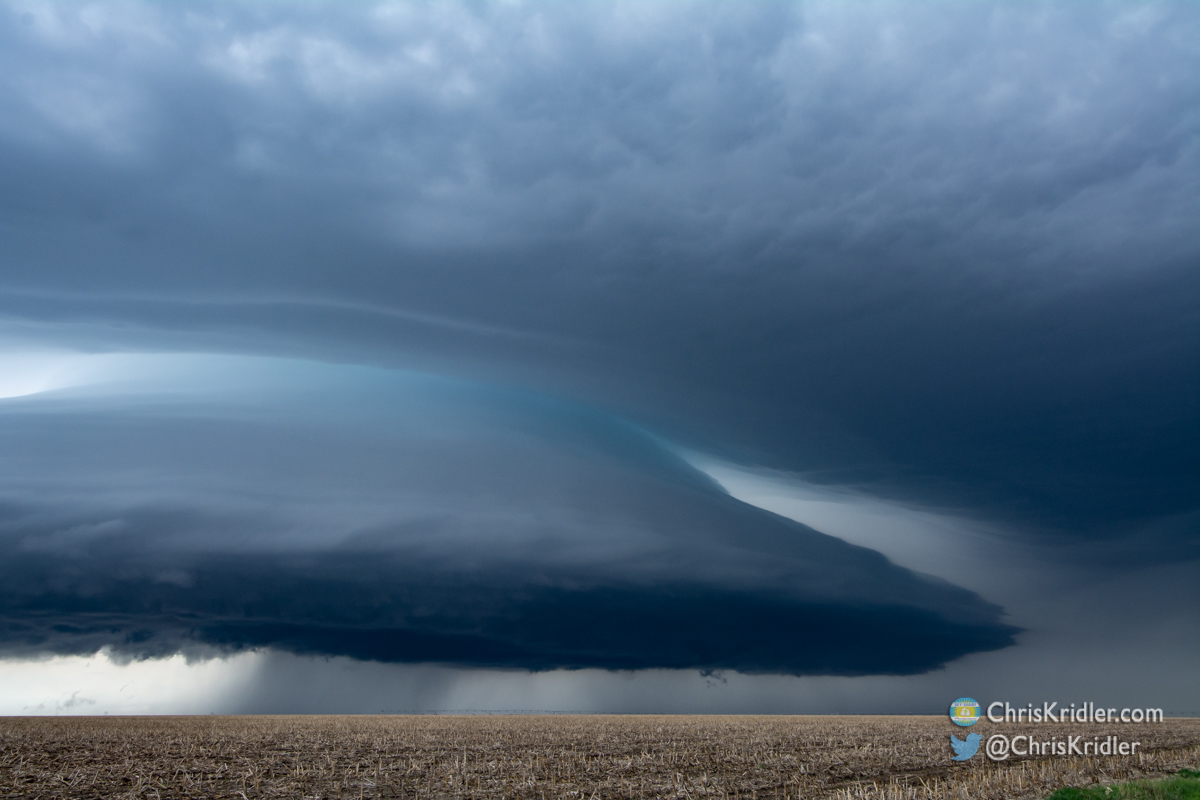
This is one of my favorite images – the sleek structure over the simple field.
And oh, what a chase it was! This mothership supercell was not only spinning but absolutely beautiful. (The timelapse video says it all.)
This kind of structure is rare — and almost unheard of at 11 a.m.! I was enraptured, and we followed it north of Colby for a while until we had to make a choice and reposition for potentially tornadic storms later in the day.
Those started early, too – one too far southeast of us to catch, and more up in Nebraska. We met up with Bill Hark and Jason Persoff in Oakley and debated which way to go. And ended up not seeing any of the tornadoes. That said, we finished off the day with beautiful skies anyway: bubbling convection, a glorious sunset, and staccato lightning as the moon rose over the storms.
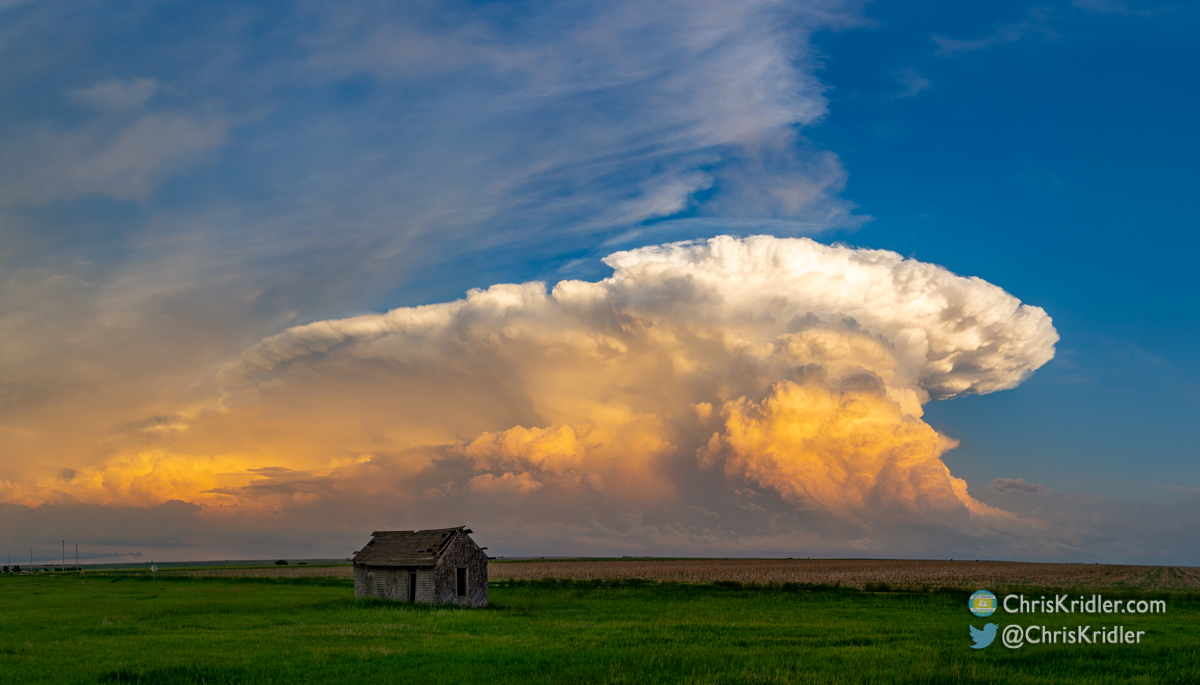
We found an abandoned structure in front of this beautiful storm northeast of Dresden, Kansas.
It’s hard to be disappointed in a day that offers such a visual feast.
Roll over a photo to see a caption, or click on any picture to start a slide show of larger images.

Follow the yellow brick road … at Dorothy’s House in Liberal, Kansas.
So on May 25, Alethea Kontis and I both needed a break – even as we agreed to keep an eye on the atmosphere for the possibility of storms later in the day. We didn’t want to drive too far to get them. Fortunately, waking up in Liberal, Kansas, offered a perfect opportunity for rest, relaxation — and chasing.
We had a real breakfast, for once, at the Pancake House, a fantastic spot in Liberal, with fellow chaser Bill Hark, who joined us later for some tourism at Dorothy’s House and the Coronado Museum. The museum had a lot of interesting artifacts, and Dorothy’s House offered a snapshot of what an early 20th century prairie house might have been like. (What? Dorothy didn’t have indoor plumbing?) And that big warehouse behind Dorothy’s House with the “Land of Oz” sign that always puzzled me — we found out what it was! It’s where the young woman playing Dorothy gave a one-woman show very much in the wild and weird spirit of The Wizard of Oz, leading us through vignettes inspired by the movie.
After a delicious food-truck hamburger, we had to make a decision. We had reservations in Colby, Kansas, that night, which was at least a couple of hours’ drive north, in hopes of chasing quality storms the next day. Bill decided it wasn’t worth chasing marginal storms to our south and headed out. We opted to take a look at the bubbling CU (cumulus clouds), which I found irresistible.
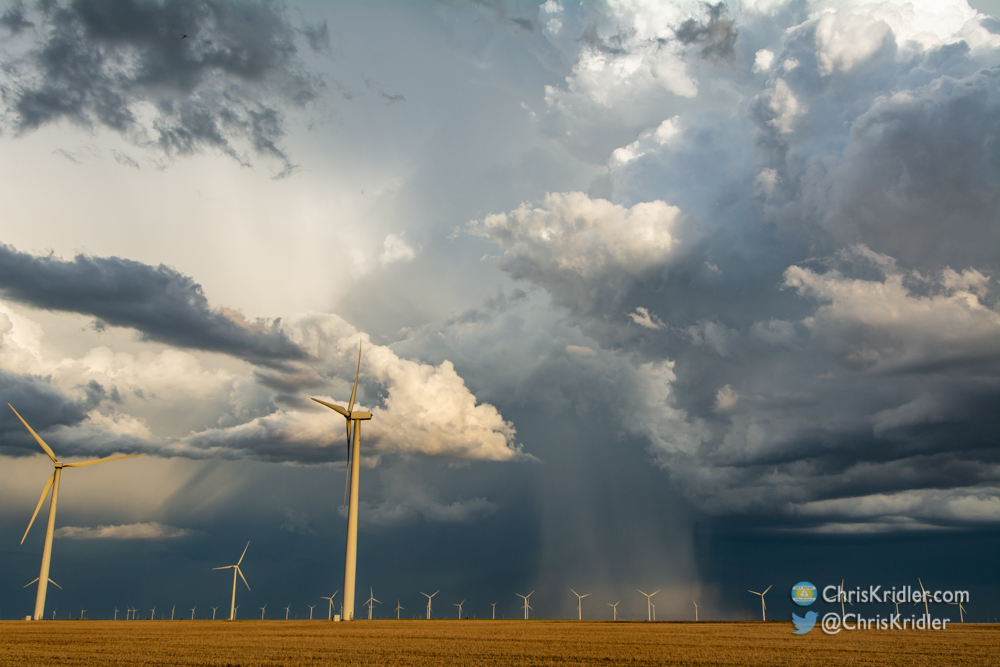
We photographed this hail shaft in the golden late-afternoon light amid the wind turbines.
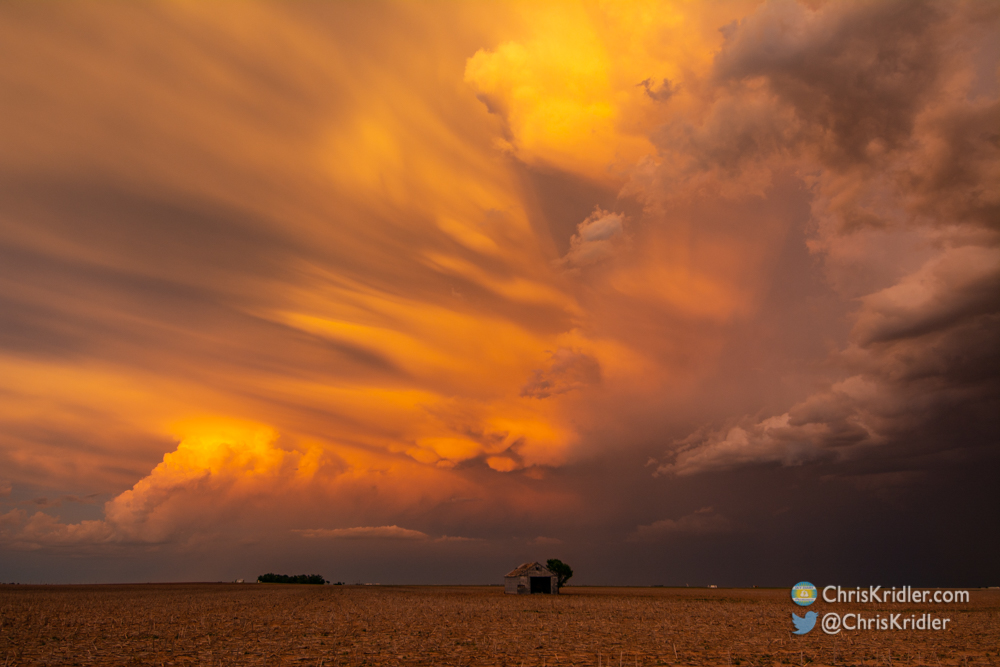
The ever-changing colors of the sunset were captivating.
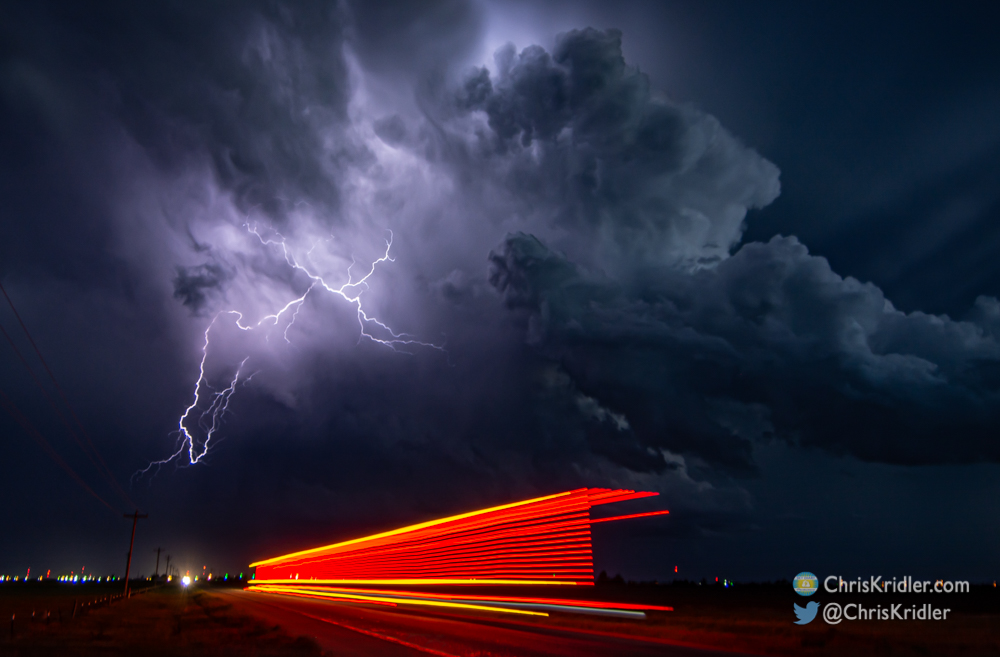
The lights of a passing truck frame the lightning storm.
We finally left the storm to drive north, knowing we’d pay for our chase with sleep deprivation. Still, at Alethea’s urging, we paused in Kansas to see if we might capture sprites. Only it was clear we wouldn’t, because a full moon lit up the prairie with an eerie glow that would have washed out sprites in any photos. Plus, we’re still trying to figure out how to shoot sprites! Still, I captured a meteor in one of my photos. Nothing like a shooting star to end a magical day.
Roll over each picture to see a caption, or click on any one to start a slide show of larger images.
All of this is to say that May 24 actually had one of the most photogenic tornadoes of the season in Kansas, but we missed it. And I didn’t mind all that much, because we saw a spectacular supercell with incredible structure like nothing I’d seen before.
Truth is, that’s one of the appeals of storm chasing: Every storm is like nothing you’ve seen before, only some are more unusual than others. This one qualified.

At Pence, Kansas, northwest of Scott City, inflow suddenly increased into the first storm we targeted, and rotation in this area picked up.
Alethea Kontis and I joined Jason Persoff and Bill Hark, though as usual, we ended up on different parts of the storms for much of the day. Our initial target was what looked like a promising area south of the front in southwest Kansas, where there was some clearing, allowing the sun to heat up the atmosphere and provide fuel for the storms. (The impressive tornado at Selden occurred farther north.) We had to drive through murky fog to get to our target but, in the clear air, were treated to bubbling cumulus and storms in progress.
Our first storm was north of Leoti (where I saw a gorgeous layer-cake supercell in 2016), and it was spinning. It even looked like it might try to put down a tornado, but it couldn’t get its act together. As it went into an area of questionable roads, we went south, east, north and west again to catch up with it. For a moment, northwest of Scott City, it started sucking in inflow and had a big area of serious rotation. I really thought it might drop a tornado – and then the outflow took over, killing the storm’s chances. The bright side: It was gorgeous!
Then it was decision time, and our decision was to go after new storms developing to the southwest. So after more repositioning, we got in front of the storm near Holcomb.
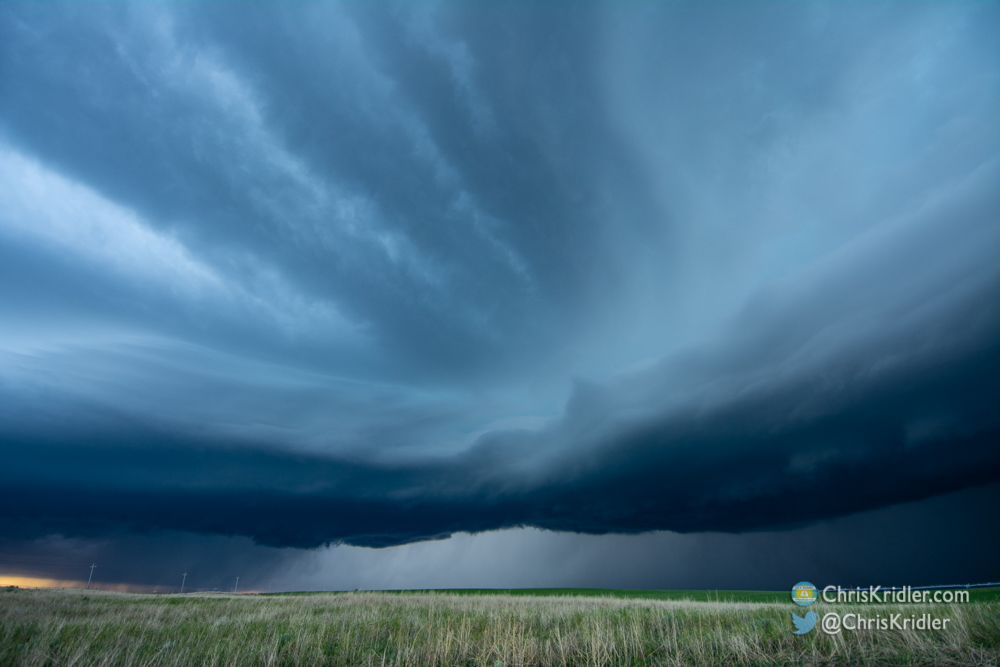
The storm we chased from near Holcomb to south of Garden City had incredible structure. At its heart, a huge laminar inflow feature (at right) flowed into the base of the storm.
Roll over a photo to see a caption, or click on one to start a slide show of larger images.
I really don’t love chasing storms traveling at highway speeds, especially when they’re packed with hail. I’m hail-avoidant on a good day, thanks to previous experiences with being pummeled by hail, and with a new car? Well, perhaps I’m even more cautious.
So when Alethea Kontis and I traveled south of Limon, Colorado, on May 23, 2021, to meet a rotating storm hurtling north, we had to make a decision. And personally, I didn’t want to try to keep up while playing dodgeball with what was quickly becoming a line of hail-filled storms. Some folks saw tornadoes who pursued it. Some didn’t. And some took a hail bath while they were chasing it.

A few crawlers lit up the night.
We opted to try to catch storms forecast to form farther east, but those storms were never that vigorous or organized in spite of screaming-fast surface winds. Still, we saw a funnel at the end of the original line, and I wondered if there was any circulation on the ground.
The day was redeemed by a fantastic lightning show at Burlington, Colorado. The timelapse in the video is really nifty.
Roll over a photo to see its caption, or click on an image to start a slide show of larger pictures.
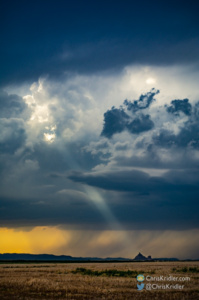
We shot some photos looking toward Courthouse and Jail Rock in western Nebraska.
We started and ended the day in Sidney, Nebraska, and any storms that formed were screaming north at highway speeds. It was almost impossible to keep up with them. Perhaps the only highlight was seeing some of the pretty rock formations of western Nebraska silhouetted against the storm-tempered light.
I do have a few photos from the day. Roll over one to see its caption, or click on one to see a slide show of larger images.
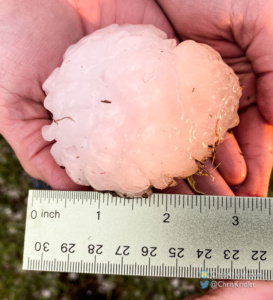
The biggest hail we saw was about three inches across.
May 20, 2021, Alethea Kontis and I targeted northeastern Colorado, hoping for supercells. Bill Hark joined us for much of the chase. Storms took a long time to get going, and when they did, the lack of roads made it difficult to be on the “right” side of them … but we had a beautiful view of hail and rainbows (or hailbows) from the west.
We also picked up some very large hail on the road, up to three inches in diameter — hail I was very grateful not to drive through.
Roll over a photo to see its caption, or click on one to start a slide show of larger images.
After a hearty diner breakfast with friends in Lubbock, Texas, near the Buddy Holly Center, where we checked out a few of the outdoor exhibits, Alethea Kontis and I decided to check out the chance of a storm southwest of us. And there was a storm, which we caught up with near the town of Loop.
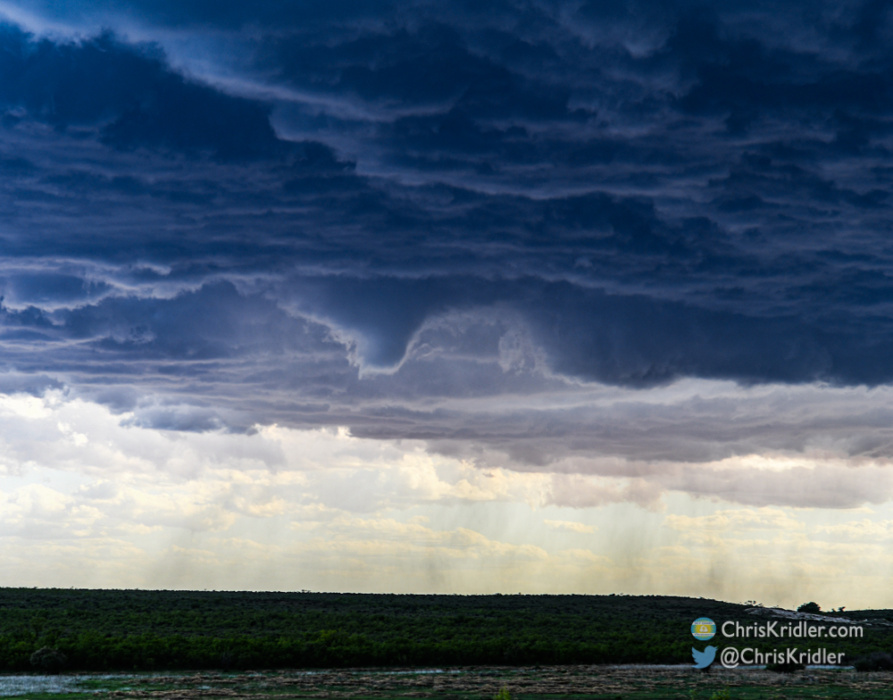
A funnel cloud spun slowly under the base. A tornado spinup was reported somewhere around this time, but we could not see the dust whirl.
This was a slow-burning cell, kicking up dust and roiling underneath. It slowly began to spin and became severe-warned, and it was clear from the radar it was producing a lot of hail, which we had to stay ahead of. We saw gustnadoes and later funnel clouds about the time a brief tornado was reported, though we didn’t see the dust whirl.
By the end of the day, the storm attained a beautiful, laminar appearance at sunset. We photographed it while hanging out with the cows and later drove through the lightning on the way to our hotel. For a marginal day, it was a fun chase.
Roll over a photo to see the caption, or click on one to start a slide show of larger images.
Jason Persoff found us by the side of the road. He was chasing with his son Kai, and we all headed north of town to watch the developing storms.
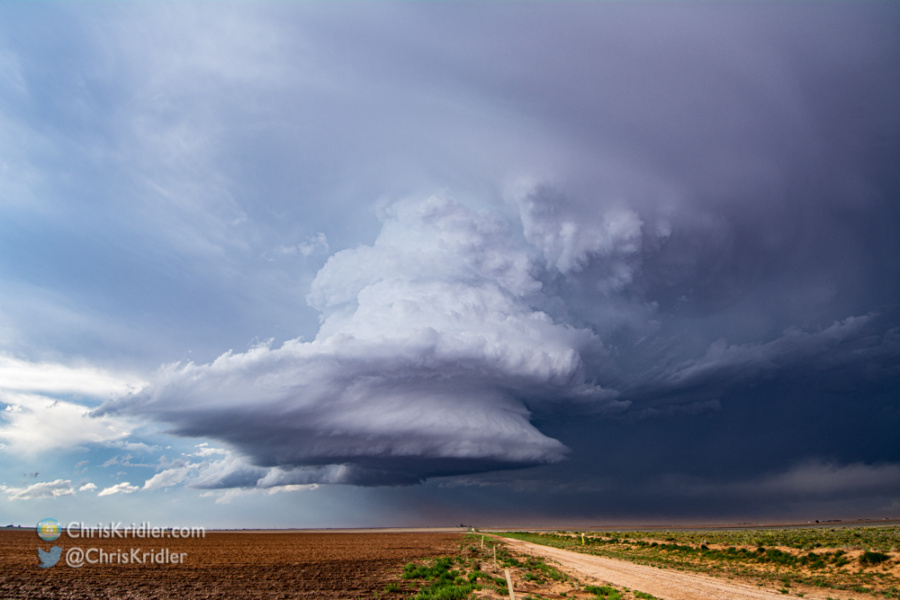
What a beautiful storm.
The first ones seemed to deflate quickly, but soon a small LP (low-precipitation) storm began to dominate the area around Brownfield. While a nice cone tornado occurred in the line of storms farther south, this one produced what was essentially a dust whirl under a nub of a funnel. Even though we were filming it, we didn’t see the whirling dust – probably because there was so much other dust in the way.
There’s a lot of timelapse in my video, and this spinning storm sometimes resembled a UFO descending upon the Earth.
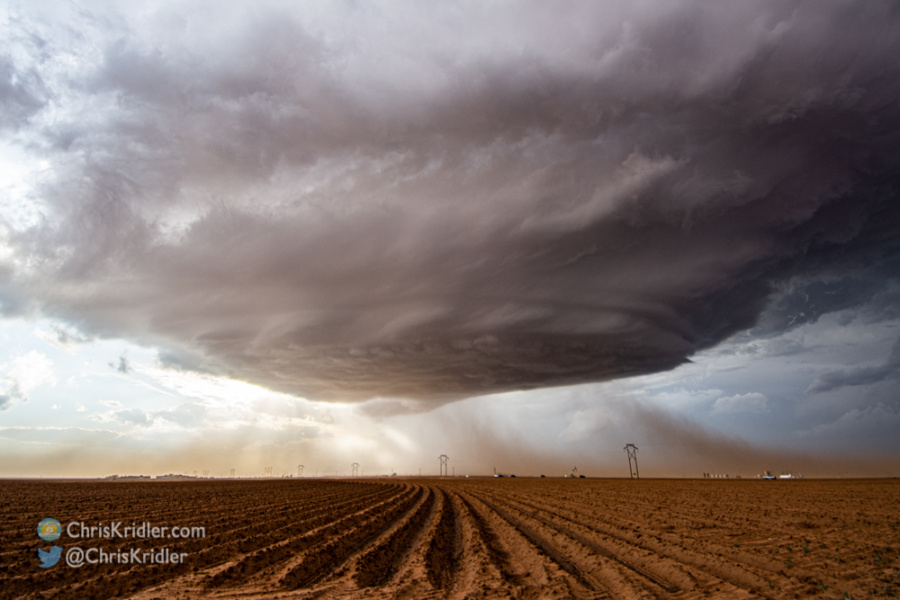
The brown fields of Brownfield reflected their color on the base of the storm.
Brownfield literally has a lot of brown fields, and interestingly, their color was reflected in the bases of the storms. So while I always enhance photographs to a point — I’m leaning more toward artistic photos these days rather than the flat, documentary style — those brown and rust colors are pretty much true to life.
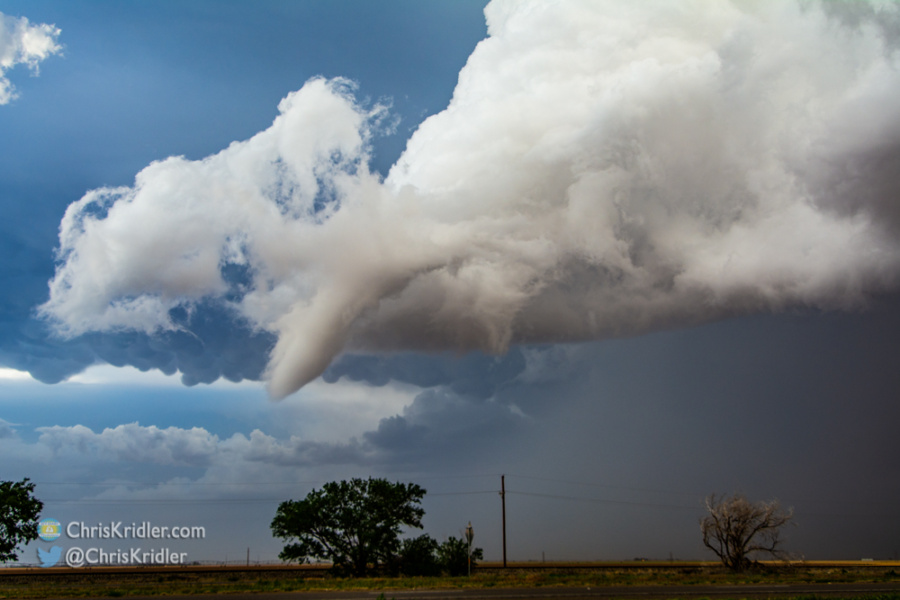
As we got into Lubbock, with the tornado sirens blaring, this funnel almost made it to the ground.
The storm moved into the south side of Lubbock and produced a long, white funnel that was just shy of stirring up circulation on the ground — i.e., no tornado.
We watched the storm as it became disorganized but still produced a glorious display of convection, lightning and mammatus clouds at sunset. All in all, it was an exhilarating chase day with lots of photo opportunities.
Roll over a photo to see a caption or click on one to start a slide show of larger images.
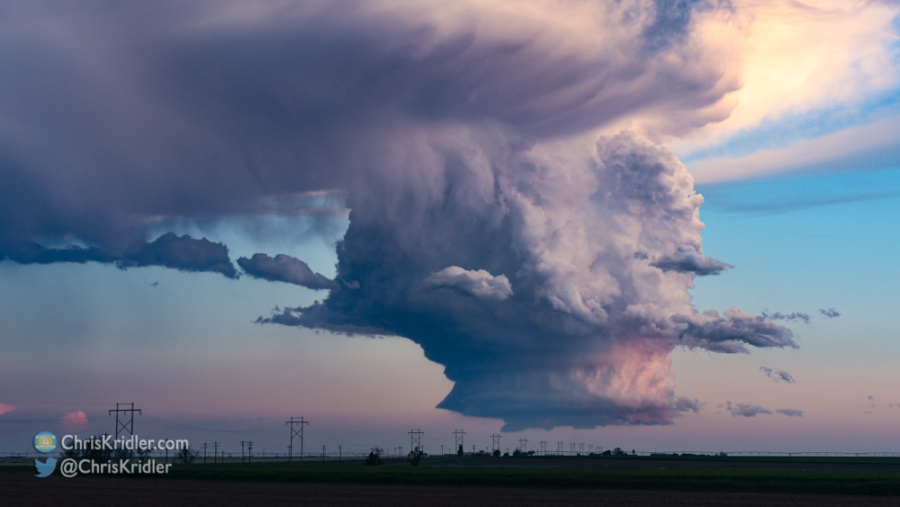
The storm turned a delicate pink at sunset.
The storm didn’t produce another tornado, but it was uniquely beautiful, especially with the mammatus, which slid away as dusk fell.
One thing that stays true about storm chasing, even in my twenty-fifth season (yes, you read that right), is that it’s really hard to get enough sleep on the road, let alone enough time to publish all the photos and videos I shoot. We drive constantly, and there’s not a lot of time to sit at a computer for hours processing photos and video. To be brutally honest, I still have some chases for which I’ve never posted the photos in previous years. And this year, though I am doing my best to stay current, I’ve already fallen behind. So although I’m writing this on May 20, I’m dating this post May 16, 2021, which is the day the event occurred.
